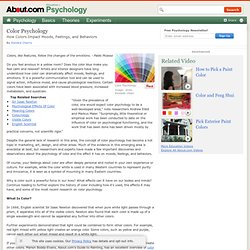

Psychology of colour. Online secured loans offers UK homeowner and tenants loans.

Our team of experts search over 2000 loan plans to get the best deal. Home owner loans from £1000 up to £100,000 and personal loans from £500 to £25,000 at competitive rates starting from 6.3% APR to 27.9% APR for people with severe credit problems. If you're a UK home owner you can consolidate up to £30,000 at just 6.3% APR, typical 8.7% APR now, the lowest rate in the UK. Think carefully before securing other debts against your home. Your home may be repossesed if you do not keep up repayments on a mortgage or any debt secured on it. Psychology Of Color. Colour Psychology. Colour psychology is the study of the effect that colours have on human behaviour particularly the natural instinctive feelings that each colour evokes.

Colour preference is subjective however colour psychology reveals how each colour creates a collective emotional, mental and physical response in people as a whole. Red for example will create feelings of warmth, movement, ambition, determination and sometimes anger! Red may bring to mind sayings that have been passed down through the ages such as 'it was like holding up a red rag to a bull!
' Cultures from around the world may differ in their use of colour symbolism and psychology for example in South Asian culture it is common for a bride to marry wearing red where as in Western culture a bride traditionally wears white. Colour Affects Us all on a Daily Basis Colours in our environment affect us on a daily basis, they can act as unconscious triggers that influence how we think, feel and react to the world around us.
All rights reserved. How It Works - Colour Affects. What exactly is colour psychology?

It is the effects of the electro-magnetic radiation of light on human mood and behaviour - a universal, psychophysical reaction, which is not as heavily influenced by culture, age and gender as is generally thought. It is important to understand that there is a great difference between colour psychology and colour symbolism. Historically, what is often described as colour psychology is actually colour symbolism - the conscious associations that we are conditioned to make. Cultural responses to colour derive from a variety of causes: for example, green is the sacred colour throughout Islam, being the colour of the Prophet's robe; in Ireland it is considered lucky, perhaps because when the world around us contains plenty of green this indicates the presence of water and therefore little danger of famine; in England it is considered unlucky, possibly because of its association with decay and disease.
How does colour psychology work? Not so. Color Psychology. By David Johnson Like death and taxes, there is no escaping color.

It is ubiquitous. Yet what does it all mean? Why are people more relaxed in green rooms? Why do weightlifters do their best in blue gyms? Colors often have different meanings in various cultures. Black Black is the color of authority and power. White Brides wear white to symbolize innocence and purity. Red The most emotionally intense color, red stimulates a faster heartbeat and breathing. The most romantic color, pink, is more tranquilizing. Blue The color of the sky and the ocean, blue is one of the most popular colors. Green Currently the most popular decorating color, green symbolizes nature. Yellow Cheerful sunny yellow is an attention getter. Purple. Color: Meaning, Symbolism and Psychology. Green occupies more space in the spectrum visible to the human eye and is second only to blue as a favorite color.

Green is the pervasive color in the natural world that is an ideal backdrop in interior design because we are so used to seeing it everywhere. The natural greens, from forest to lime, are seen as tranquil and refreshing, with a natural balance of cool and warm (blue and yellow) undertones. Green is considered the color of peace and ecology. However, there is an "institutional" side to green, associated with illness or Government-issued that conjure up negative emotions as do the "slimy" or bilious greens. How the color green affects us physically and mentally * Soothing * Relaxing mentally as well as physically * Helps alleviate depression, nervousness and anxiety * Offers a sense of renewal, self-control and harmony For more information see "All About the Color Green"
Color Psychology - The Psychology of Color. Colors, like features, follow the changes of the emotions. - Pablo Picasso Do you feel anxious in a yellow room?

Does the color blue make you feel calm and relaxed? Artists and interior designers have long understood how color can dramatically affect moods, feelings, and emotions. It is a powerful communication tool and can be used to signal action, influence mood, and cause physiological reactions. Certain colors have been associated with increased blood pressure, increased metabolism, and eyestrain. "Given the prevalence of color, one would expect color psychology to be a well-developed area," note researchers Andrew Elliot and Markus Maier. Color Psychology.